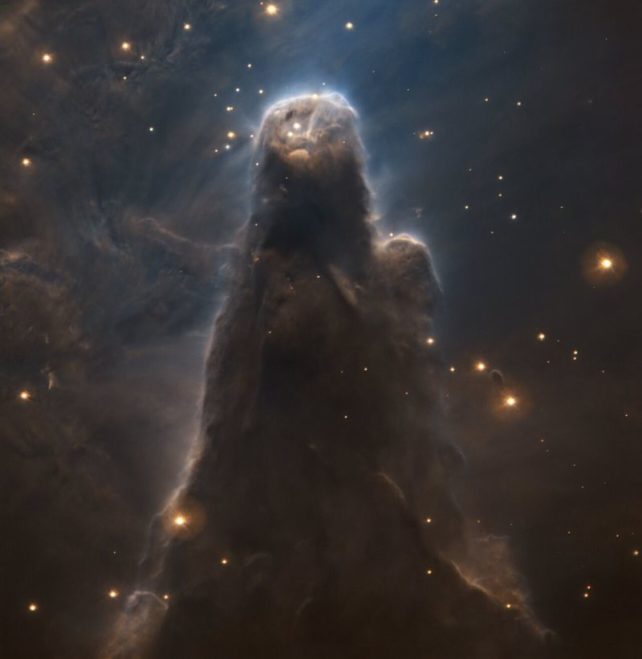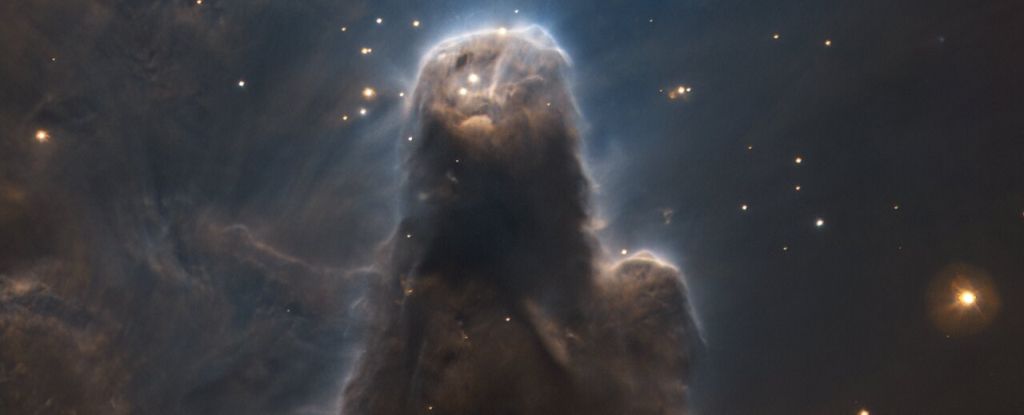Look deep enough into the darkness of space, you'll find all manner of shapes that stir the imagination. Keep staring, you'll quickly learn that our Universe can be so much stranger and more wondrous than anything the human mind can dream of.
A recent image released by the European Southern Observatory (ESO) has captured just a small glimpse of that on a cosmic scale: a dark nebula 7 light-years long looking like a titanic lighthouse keeping watch over the cold, black void of space.
Perhaps it's a cyclopean giant seeking planets to devour. Or death itself, haunting the heavens, cloaked in shadow.
Far from a destroyer of worlds, this darkness represents something far more fertile.
The new image comes from ESO's Very Large Telescope to celebrate the observatory's 60th anniversary. The image's eerie subject is the Cone Nebula, part of a larger complex 2,500 light-years away called NGC 2264 in the constellation Monoceros (the Unicorn).
It might not look like most other nebulae you're accustomed to seeing, glowing brightly with a complex array of colors. That's because not all nebulae are the same. Some reflect the light of nearby stars. Some, ionized by the stars within them, emit their own light.
And some, like the Cone Nebula, are dark, thick with dust that absorbs visible light. Only light at wavelengths invisible to the human eye, such as infrared and radio, can penetrate them.

The full image of the Cone Nebula from ESO's Very Large Telescope. (ESO)
Opaque nebulae of this type are known as molecular clouds. These include some of the most interesting nebulae to be found: places where baby stars are born. The dust is an efficient emitter of infrared light, which carries away thermal energy and causes the cloud to cool. Without the outward pressure supplied by heat, gravity overwhelms the clumps of the dust and gas and forces them together.
It's these dense clumps form the seeds of stars; spinning, they draw in even more mass from the surrounding cloud, providing the growing protostar with the pressure needed to kick-start fusion in its core.
At a certain mass, the star produces what astronomers call feedback. Jets of plasma accelerated by the star's magnetic field lines erupt from its poles, and powerful radiation pressure generated by the star's ultraviolet light. Both contribute the a stellar wind that pushes away material from the baby star.
This is what gives the Cone Nebula its iconic shape. Baby stars, burning blue and hot (although appearing gold in color in the new image), are at the stage of their life where their feedback is blasting away at the dusty nebula. Similar processes carved out the famous Pillars of Creation structures within the Eagle Nebula.
Because infrared light can penetrate these dense clouds, instruments that can see the Universe in infrared light – such as the James Webb Space Telescope – are invaluable for revealing the particulars of the star formation processes that take place therein.
But visible light images, like the VLT's, show details that disappear in other wavelengths. It's only by studying the full spectrum that we can obtain a comprehensive understanding of everything at play in these enigmatic, fascinating structures.
You can download wallpaper-sized versions of the new image from the ESO website.
- new1born
-

 1
1




Recommended Comments
There are no comments to display.
Join the conversation
You can post now and register later. If you have an account, sign in now to post with your account.
Note: Your post will require moderator approval before it will be visible.